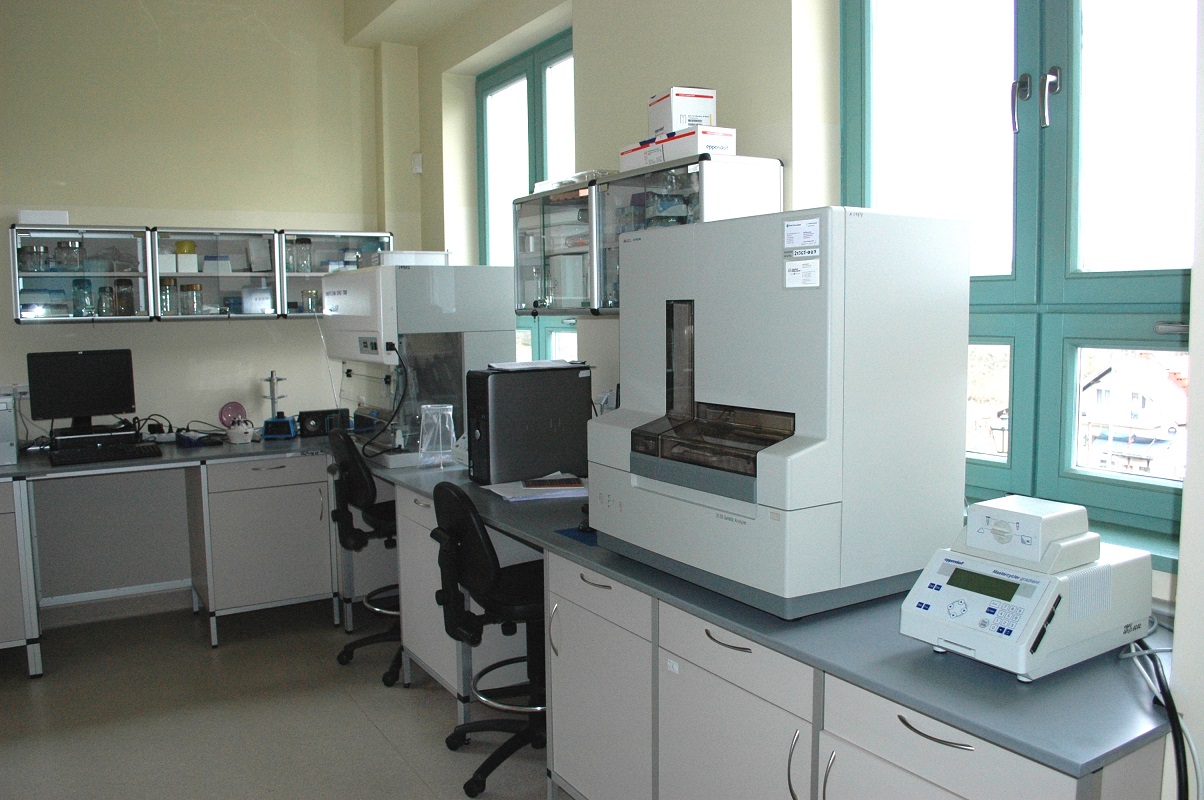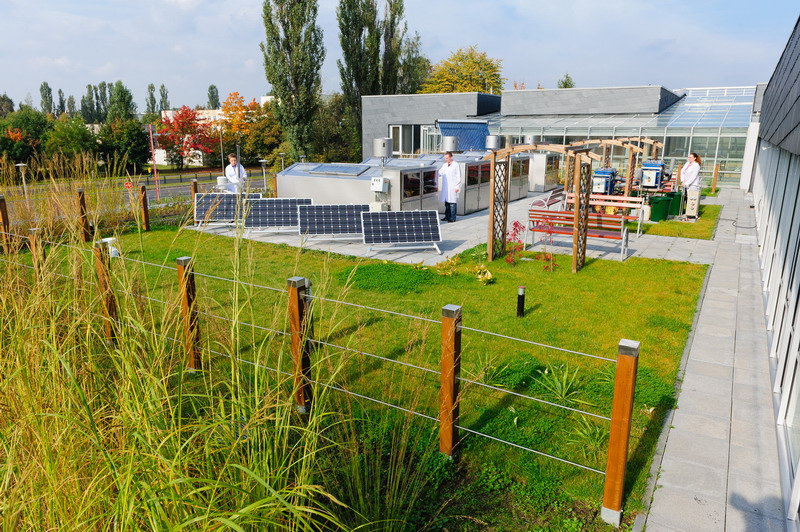Environmental Biotechnology
Degree to be obtained
Master of Environmental Engineering- specialization Environmental Biotechnology
We offer a Master’s course in Environmental Biotechnology for international students. Environmental Biotechnology is an exciting, fast-growing interdisciplinary field with excellent career opportunities. Our graduates with a Master’s degree in this field possess skills in engineering and molecular biology that are in demand in a wide range of industries and scientific fields. Our teachers have years of experience in teaching international students. They are actively involved in the field, with a variety of ongoing research programs and many international publications. We are committed to both practical and theoretical education, so our Master’s students work with us on our research projects in our modern laboratories. Graduates from our program possess advanced knowledge of natural sciences. They have technical expertise in the field of biotechnology, including bioenergy technologies. They can solve problems related to the use of the natural environment using various technologies, including remediation. They use molecular techniques as a tool to draw conclusions about the state of the environment. When dealing with damage to the environment, they can identify the risks and take action to restore environmental balance. Our graduates understand the desirability of continuing education, professional development and international cooperation, and are well prepared for doctoral studies if they choose this career path. With this combination of skills and attitudes, our graduates are well prepared for a successful career in industry or academic institutions.
Duration
3 semesters (1.5 years)The studies start in February of a particular academic year.Language
EnglishTuition
The cost is 10 000 PLN (approx. 2350 EUR or 2700 USD) for the 1st year (two semesters) and 5000 PLN (approx. 1175 EUR or 1350 USD) for the 2nd year (one semester).Application
Application is up to the beginning of February but apply much earlier if you need to obtain additional documents, e.g. a visa.Requirements
The course is open for applicants who have successfully completed a Bachelor’s degree with 210 ECTS or equivalent, or applicants who have completed a Master’s degree in one of the following areas: biotechnology, environmental engineering, chemical and process engineering, environmental protection, civil engineering or any similar subject. The admission procedure requires the Bachelor’s Degree Diploma with a transcript of records.Contact
For questions about these studies, please contact:
Dr Hab. Eng. Magdalena Zielińska Faculty of Environmental Sciences
Faculty of Environmental Sciences
E-mail: magdalena.zielinska@uwm.edu.pl
Phone: +48 89 523 4185
Fax: +48 89 523 4131
Dr Hab. Eng. Agnieszka Cydzik-Kwiatkowska
Faculty of Environmental Sciences
E-mail: agnieszka.cydzik@uwm.edu.pl
Phone +48 89 523 4194
Fax: +48 89 523 4131
Why study at the UWM in Olsztyn
● Over 65 years of Faculty history
● Hospitality to foreign students
● Poland is a member of the European Union
● Largest university in north-eastern Poland
● Located in the ”green lungs of Poland”, with many forests and 16 lakes in our city
● Most beautiful academic campus in Poland
● Unforgettable student festival held every May from 1959
● Low costs for accommodation and transportation
Feedback from our students
Opinion #1
Program description
Year | Sem. | Course |
1 | 1 | English support |
Organic chemistry | ||
Analytical techniques State Environmental Monitoring - definition, objectives, structure and tasks. Measurements to assess the quality of soil and water. Chemical analysis of water quality using spectrophotometric and titration methods. Application of advanced analytical methods (microwave extraction/mineralization, high pressure liquid chromatography, flame atomic absorption spectrometry) in determination of pollutant concentration in soil. Statistical analysis of monitored data. | ||
Toxic chemical risk Toxic chemical risk as science. Environmental pathways of toxic chemicals. Dose effect. Toxicity testing in animals. Studies of human populations at risk. The body’s defenses against chemical toxicity. Mechanisms of chemical disease. Human health risk assessment. Ecological risk assessment. Managing chemical risk. User manual of the molecular biology equipment. Pippetting micro volumes of liquids with different physical properties (density, viscosity). Lethal toxicity tests on fish. Calculation of median lethal concentration (LC50), median lethal time (LT50) values, and toxic unit number. Phytotoxicity assessment using PHYTOTOX kit for tests on monocotyledonous (sorghum) and cotyledonous plants (cress, mustard). Physiological endpoints of toxicity: examination of blood smears and liver sections of fish exposed to polycyclic aromatic hydrocarbons (PAHs) using light microscopy (laboratory classess). Molecular toxicology: analysis of gene expression after exposure to model toxic substance. Genotoxicology: assessment of genotoxic effect of PAHs on fish’s erythrocytes and hepatocytes using the comet assay. Risk assessment: hazard identification, analysis of exposure, analysis of effects, rick characterization. | ||
Technical biocenoses Relation between the operational parameters of wastewater treatment and microbial structure and activity of biomass. Presentation of the biomass cultivation technologies in wastewater treatment systems: activated sludge, biofilm, aerobic granular sludge. The role of extracellular polymers (EPS) in formation of complex microbial structures. Microorganisms of methane fermentation. Bioaugmentation. Microbial succession during composting. The use of molecular techniques for study of complex microbial consortia in technical systems. Visit in a full-scale wastewater treatment plant. Enzymatic activity of the biomass. Evaluation of the effectiveness of nitrogen conversions by activated sludge depending on the operational parameters of wastewater treatment. Nitrogen balance in wastewater treatment systems. Evaluation of the abundance and diversity of nitrogen-converting microorganisms using molecular biology methods, depending on the operational parameters of wastewater treatment. Theoretical bases of high-throughput sequencing. | ||
Designing of wastewater treatment systems Wastewater engineering overview for wastewater treatment solution and sludge disposal. Typical plant configuration. Impact of flow rate and mass-loading on design of wastewater treatment plant. Physical unit operations. Chemical unit processes. Biological unit processes. Technological parameters. Design of facilities for physical and chemical treatment. Design of facilities for the biological treatment of wastewater. Need for advanced wastewater treatment. Design of facilities for the treatment and disposal of sludge. Effluent quality and disposal. | ||
Molecular biotechnology Introduction to molecular biotechnology and molecular biology of microorganisms. The basic tools of genetic engineering. Molecular methods (RISA, DGGE, T-RFLP) of microbial diversity analysis. Indices of biodiversity. Methods of bacterial activity measurement (mRNA and bioreporter strains). Microbial activity during bioremediation processes. DNA extraction from bacterial communities. Amplification of catabolic gene fragment by PCR. Detection of catabolic genes. Ribosomal Intergenic Spacer Analysis. Estimation of microbial community biodiversity using molecular approaches. Polyacryloamide gel electrophoresis. Quantification of the catabolic genes. Analysis of DNA fingerprints. Plasmid isolation from E. coli. Plasmid restriction analysis. Agarose gel electrophoresis of digested plasmids. | ||
Bioprocess engineering Kinetics of simple chemical reactions used in biochemical engineering. Determination of the rate constants and reaction rates in processes during wastewater treatments. The kinetics of microbial growth-Monod equation. Determination of rate constants of microbial growth. Sludge production in activated sludge systems. Material balances. Technological concepts of organic compounds removal and nitrification in activated sludge systems based on the kinetic constants. Kinetics of adsorption process. Determination of the constants in the Langmuir and Freundlich models. | ||
Facultative course (module A) | ||
Professional internship | ||
2 | Statistics in environmental sciences The role of statistics in environmental science. Environmental sampling. Models from data. Drawing conclusions from data. Impact assessment. Time series analysis. Spatial data analysis. Censored data. Risk assessment. | |
Environmental management Sustainable development conception. Idea of environmental management systems. Implementation of EMS. Deming’s cycle. ISO standards about environmental management – ISO 14001 standards family. Environmental audits, certification audits, verification audits. Eco-management and audit scheme (EMAS). IPPC directive. BREF documents. BAT techniques in different kinds of enterprises. Environmental policy. Integrated permits. Environmental management system’s documentary. | ||
Environmental biotechnology Biotechnology in environmental protection – definitions and objectives. Aerobic and anaerobic processes of wastewater treatment. Activated sludge – removal of organic compounds, nitrogen and phosphorus. Bed biofilm reactors – characteristic and dividing criteria. Aerobic and anaerobic methods of stabilization of sewage sludge. Composting as a process of sewage sludge final disposal. Determination of efficiency of organic compounds removal and nitrification in rotating biological contactor. Evaluation of wastewater treatment efficiency by activated sludge in continuous flow reactor. Determination of operational parameters of activated sludge. Determination of efficiency of organic compounds, nitrogen and phosphorus removal in sequencing batch reactor (SBR). Calculation of biogas yield and operational parameters during anaerobic digestion of sewage sludge. Evaluation of the usefulness of compost from sewage sludge for agricultural use as organic fertilizer, based on selected physico-chemical parameters. | ||
Biotechnology of solid waste Quantitative and morphological characteristics of solid waste. The rules of the selection of mechanical-biological treatment of solid waste. Segregation processes. Composting as a method of stabilization and drying of solid waste. Fermentation carried out in the reactors and in the landfill heap of solid waste. Aerobic methods of stabilization of solid waste. Bioaugmentation. Biotechnological methods of landfill leachate disposal. Biological methods used for purification of gases and odors generated in the biological stabilization of solid waste. Technological project of waste management plant. Treatment method for biodegradable waste. Sources of waste. Individual indicators of waste collection in the city and in the country area. The amount and the composition of municipal solid waste. Calculating developed outside the headquarters of storage and landfilling. Calculations technological composting reactors and heaps smuggled. Project for the disposal of organic waste using the fermentation process. | ||
Bioremediation Introduction to bioremediation Definitions of bioremediation. Fundamentals of microbial remediation techniques. Type of microorganisms for bioremediation. Microbial degradation of selected contaminants in soil and groundwater. Factors influencing the microbial degradation of contaminants. Design and monitoring of bioremediation. Advantages and disadvantages of bioremediation. Classification and characterization of bioremediation methods. Application of natural amendments in soil bioremediation. Phytoremediation for treatment of soils contaminated with organic and inorganic pollutants. Design of bioremediation for soils contaminated with petroleum and heavy metals. Laboratory project of soil bioremediation with natural, organic amendments. Laboratory project of soil bioremediation using natural washing agents. Presentation of the project results. | ||
Biocatalysis and biotransformation in environmental biotechnology The uses of enzymes and whole-cell systems in an industrial context. Whole cell and isolated enzyme systems. Pros and cons of biocatalysis versus both traditional chemical transformation and other catalytic systems. Enzyme structure, mechanism and kinetics, the use of essential cofactors and recycling. The feasibility of a reaction on an industrial scale and reactor design. Bioconversion, biotransformation and bioremediation with enzymes and whole-cell catalysts. Characteristic of selected enzymes. Influence of medium composition and physical parameters on enzymes activity. Determination of enzymes activity, stability and kinetic. High throughput methods for enzymes selection and screening. Methods of enzymes and cells immobilization. Application of nanomaterials for enzymes immobilization. Characteristic and application of lipolyti c enzymes in environmental biotechnology. Biodegradation and biocatalysis database. Discussion of the recent application of enzymes and microorganisms in environmental biotechnology. | ||
Membrane techniques in environmental engineering Membrane techniques of the separation. Types and characteristics of membrane processes. Types of membranes. Fouling and scaling. The use of microfiltration, ultrafiltration, nanofiltration and reverse osmosis in environmental engineering: water and wastewater desalination, removal of suspended and soluble organic compounds, removal of micropollutants (pesticides, PAHs, endocrine active substances) from wastewater; gas purification. Hybrid processes. Membrane bioreactors. Designing water and wastewater treatment technologies in the systems using membrane processes. Determination of the operating parameters of membrane filtration. | ||
Renewable sources of electrical energy Major sources of renewable energy, including wind power, hydropower, solar energy and photovoltaics, geothermal energy and bioenergy, and their application in power delivery systems. Basic laboratory exercises on selected power systems run through the utilization of renewable energy sources (photovoltaics), including: Ballard (hydrogen/air) and direct alcohol fuel cells, Li-ion batteries and electrochemical supercapacitors. | ||
Technologies of algae biomass production Algae – characteristics. Possibility of algae biomass use. Technological parameters of the algae biomass cultivation. Systems for algae biomass cultivation: raceways reactors, foto-bioreactors, hybrid reactors. Systems for algae biomass separation: filtration, membrane systems, centrifuge. | ||
Facultative course (module A) | ||
Foreign language (module C) | ||
2 | 3 | Facultative course (module A) |
Facultative course (module B) | ||
MA Seminary | ||
Master thesis |
Facultative courses
Module | Courses |
A | Microorganisms in industry Introduction to industrial microbiology. Microorganisms’ isolation. Culture collections and the preservation of microorganisms. Identification of microorganisms with industrial properties. Fermentation kinetics. Growth cycle. Bioreactors. Batch, fed-batch and continuous fermentation. Fermentation process control. Strains improvement. Microbial production of biosurfactants. Downstream processing. Aseptic techniques and establishing of pure culture. Culture transfer. Preparation of culture medium. The growth curve. Growth in liquid medium. Determination of biomass. Protein assays. Modeling of selected biotechnological processes Design of wastewater treatment plant and biogas plant with simulation models. Introduction to the models ASM and ADM. Characteristics of ASM and ADM simulation models. Distribution of organic matter in wastewaters and feedstocks. Structure of biochemical reactions and physico-chemical processes. Identification of parameters. Models implementation. Fractionation of the particulate and soluble organic matter in wastewater and feedstocks. Kinetic coefficients of models. Acquaintance with modeling software. Evaluation of model usability to simulate processes in wastewater treatment plant and biogas plant. Designing of agriculture biogas plants Fundamentals of anaerobic digestion. The anaerobic digestion operational parameters and the process control. Substrates and co-substrates for a biogas production. Methods of estimation of a biogas yield. Manners of biomass pretreatment and conservation. Biogas plant equipment: feedstock storage, feeding systems, heating systems, digester stirring technologies, biogas storage, biogas cleaning and utilization, digestate post-treatment. Design calculation for an agricultural biogas plant. Technology of aerobic granular sludge Formation of aerobic granules in wastewater treatment systems - relation between the operational parameters and morphology and activity of biomass. Presentation of full-scale installations based on aerobic granular sludge technology. The role of extracellular polymers (EPS) in granulation. Measurement of EPS content in granule structure. Relations between different microbial groups in granule structure. Microscopic and granulometric analysis of aerobic granules. Enzymatic activity of aerobic granules.Designing of operational parameters of a one-stage aerobic granular sludge system. Effectiveness of nitrogen phosphorus and carbon conversions in reactors with aerobic granules. Visit in a full-scale aerobic granular sludge plant. Designing biowaste treatment processes Technological aspects of biological treatment of organic waste. Selection and preparation of the substrate for biological treatment of waste under anaerobic conditions. The definition of an energetic pile. The construction and operation of an energetic pile. Optimization of the conditions occurring in an energetic pile. Methods of obtaining and processing biogas under technical conditions. Selection and preparation of the substrate for the composting process on an industrial scale. Construction and operation of a reactor for processing organic waste under aerobic conditions. Optimization of the conditions for processing the waste in the aerobic reactor. Designing the process of biological treatment of municipal organic waste in an energetic pile for the purpose of obtaining biohydrogen. Calculations on the selection and preparation of the substrate for the fermentation process, calculations of the dimensions of an energetic pile, modeling of transformations of biodegradable compounds in the prism, calculations of the water balance of a plant on the basis of variables (precipitation, waste water capacity). Modelling the formation of methane using the IPCC standard method. Designing a biodegradable waste composting reactor working under technical conditions. Calculations on the selection and preparation of the substrate to the composting process, calculations of the plant for the assumed processability of the installation, calculations of the mass balance in the reactor on the basis of variables (humidity of the waste, change of organic matter). Technologies of biopolymer production Natural polymers of industrial importance. Synthesis, properties, environmental and biomedical applications of polylactic acid. Starch: major sources, properties and applications. Chemical structure, properties and applications of polyhydroxyalkanoates (PHAs). Microbiology and biochemistry of PHAs synthesis in pure and mixed microbial cultures. PHAs production processes employing pure and mixed microbial cultures. Production of polyhydroxyalkanoates on a commercial scale, downstream processes. The effect of carbon to nitrogen ratio (C/N) in the culture medium on the efficiency of PHAs accumulation in activated sludge. Algae biomass – sources and methods of application Characteristics of algae biomass. Natural source of algae biomass. Methods of algae biomass cultivation. Algae as a source of biomass for the methane fermentation process. Algae as a source of liquid fuels. Burning and pyrolysis of algae biomass. Algae as a source of proteins. The calculation of the efficiency of the chosen methods of obtaining biomass from natural sources. The calculation of the efficiency of the algae biomas production in open systems. The calculation of the efficiency of the algae biomas production in foto-bioreactors. The calculation of biogas production using algal biomass. The calculation of oli production using algal biomass. The calculation of protein production using algal biomass. Introduction to nanobiotechnology Overview of the fundamental concepts of modern nanobiotechnology, risks and benefits of its application in the areas of health, food agriculture and forensic science. Melding of nanofabrication and biosystems and the current and future trends of nanobiotechnology. The possible effects of nanotechnological materials and devices on the environment. Bioreduction. Biosynthesis of nanoparticles (nanosilver or nanogold particles). Properties of nanoparticles. Antimicrobial properties of nanosilver. Application of nanoparticles. Immobilization of enzymes on nanoparticles. Analysis of nanobiocatalyst properties. Synthesis of biodiesel with nanobiocatalyst. Valorization of whey permeate. Biosynthesis of galactooligosaccharides. Utilization of atomic force microscopy (ATM) for nanoparticle characterization. Application of different techniques of analysis. Micelles, microemulsions and nanoemulsions preparation. Liposomes preparation. Molecular diagnostics Detection of genetic differences between animals and their populations. The PCR based tests in detection of animal diseases and evaluation of farm animals. The importance of genetic variation in conservation of endangered animal species. The issues of conservation programs that can be solved by using molecular tools. A molecular markers and techniques used in evaluation of genetic variation. Microsatellite DNA as a marker of genetic differences in humans. Examples of applying microsatellite based techniques in conservation of endangered population, evaluation of results of conservation programs and fish farming. Short tandem repeats of DNA as a tool in forensic science and detection of parenthood. The automatic capillary electrophoresis as a method applied in molecular diagnostic, measurement of DNA fragments using automatic DNA sequencer. The method of detection of microsporidian Pseudoloma neurophilia infection in zebrafish (Danio rerio). Extraction of DNA from zebra fish spinal cord. Amplification of small subunit of ribosomal DNA of Pseudoloma neurophilia by using PCR reaction. Visualization results of PCR reaction on agarose gel. The method of detection a variants of Kappa·Casein (KCN) gene in cattle using PCR RFLP technique. Extraction of DNA from cattle blood. Amplification of kappa casein gene (CSN3) using PCR technique. Digestion of PCR product with Hinf I enzyme. Separation a DNA fragments on agarose gel. The method identification of genetic differences in human based on polymorphism of microsatellite DNA. Extraction of DNA from human blood. Amplification of microsatellites D21S11, D3S1358 and D19S433 from human DNA using multiplex PCR technique. Detection of polymorphism of amplified microsatellite fragments by using automatic DNA sequencer. The basics of genotyping microsatellite loci by using Automatic DNA sequencer and evaluation of genetic differences in group of investigated persons. The microsatellite DNA as a marker of genetic variation. Extraction of DNA from fins of rainbow trout. Amplification of microsatellites OMM1036 and OMM1037, from rainbow trout DNA. Genotyping of microsatellite loci using automatic DNA sequencer. Assessment a genetic variation of investigated group of fish by using MSA and Arlequin software. Biomarkers of environmental contamination Definition and classification of biomarkers. Specificity of biomarkers. Relationship between effect and biomarker’s response. Plant's response to environmental stress. Behavioral changes of animals. Anatomical and physiological endpoints of environmental pollutants. Mutagenicity, genotoxicity, and cancerogenicity of environmental contaminants. Polycyclic aromatic hydrocarbons. Toxic metals metabolism. Oxidative stress. Endocrine Discrupting Compounds. Environmental estrogens and androgens, and their molecular mechanisms of action. Pharmaceuticals and their residues in aquatic environment. Nanoparticles – threat or chance? Biomarkers at the molecular level. Micro RNAs as an emerging tool in prognostic studies. The role of biomarkers in environmental risk assessment. The use of biomarkers in environmental monitoring. Good laboratory practice. Training pippetting micro volumes of liquids with different physical properties, i.e. density, viscosity. Preparation of the short-term waterborne exposure of zebrafish (Danio rerio) embryos to a suit of model toxic compounds. Evaluation of anatomical malformations and physiological abnormalities in the exposed zebrafish larvae. Isolation of total RNA using modified Chomczynski method. Spectrophotometric measurement of quantity and purity of the isolated RNA samples. Elimination of genomic DNA from the samples.Assessment of RNA integrity. Reverse transcription. Analysis of gene expression using real-time quantitative PCR (qPCR). Calculations of raw values obtained from qPCR and their statistical analysis. Seminar on the molecular mechanisms of action of selected groups of environmental contaminant. Genotoxicity assessment of the selected model compounds. Analysis of microscope slides images obtained by micronucleus test and comet assay. |
B | Ecological aspects of biotechnology The technique of assesement the genetic variation based on polymorphism of microsatellite DNA and automatic DNA sequencer. Evaluation of genetic variation (heterozygosity, allelic diversity, allelic richenes). Detection of individual genetic differences between populations. Estimation a genetic distance between fish from student’s group and stock in breeding centre Rutki. Example of construction and application genetic profile of fish spawners. Finding the best variant of male and female combination among groups of genetic profiles. Using the Genassemblage software for construction an optimal male/female pairing. Molecular markers as a tool in identification origin of population as well as their interactions. The programs of restitution and conservation of the bisons in Poland, lynx in Poland and bull-trout. Conservation ecology as a branch of modern ecology. Ecology as a coexistence of populations and relationship between them and environment. The basics of population genetics eg. selection, genetic drift and their consequences. Adaptation of populations to the environmental changes, stresses and anthropological changes. Informative techniques in environmental biotechnology Informative techniques as a tool in various areas of biotechnology and molecular genetic studies. Examples of software applied in designing of primers for singleplex and multiplex PCR reaction, DNA sequencing, and measurement of DNA fragments. Analysis of SNP and software used. The NCBI databases as a source of information for molecular genetic, examples of use NCBI databases and BLAST tool. Informative techniques in conservation of populations, management of genetic variation, construction of genetic profiles. The software used for detection and assessment of the bottleneck and founder effect. Bottleneck, Arlequin. The null alleles hypothesis and its impact for assessment of genetic variation, software used in assessment of probability of null allele present. Writing scientific papers How to read, write, present and publish scientific papers. Variety of publications. Planning. Organising the paper. Dealing with copyright. Outlining the paper. Writing the first draft. Writing the Abstract and Introduction. Writing the Results section. How to write the Discussions. Impact Factor (IF) and Hirsch Index (HI) (h-index). Diagrams. Photomicrographs. Charts and tables. Slides. Posters. Communication skills The definition of presence and creativity. Ten active communication skills. Four universal communication principles. The ways of expressing yourself. Training in the story telling. Preparing for an interview. The eff ective self-presentation. |
C | English for biotechnologists German for biotechnologists |




